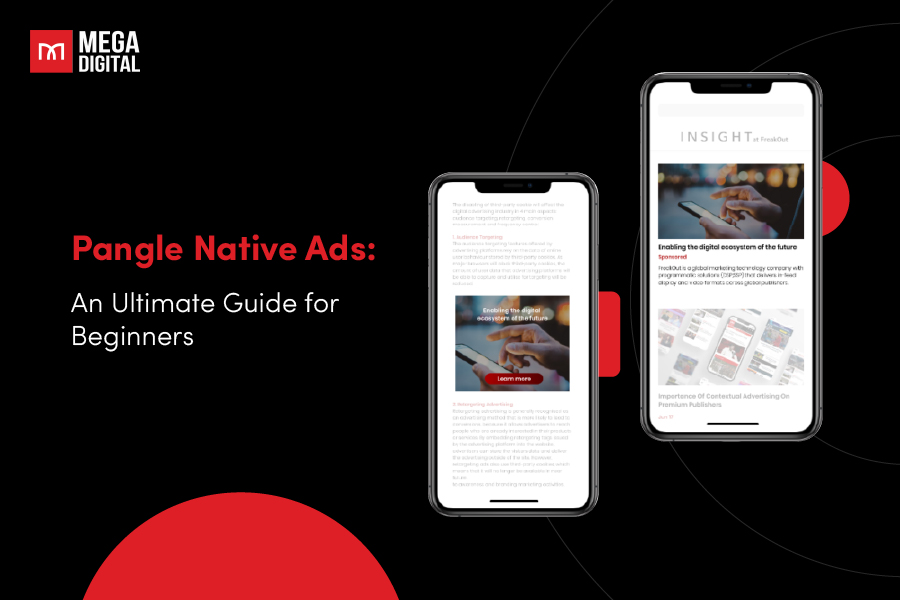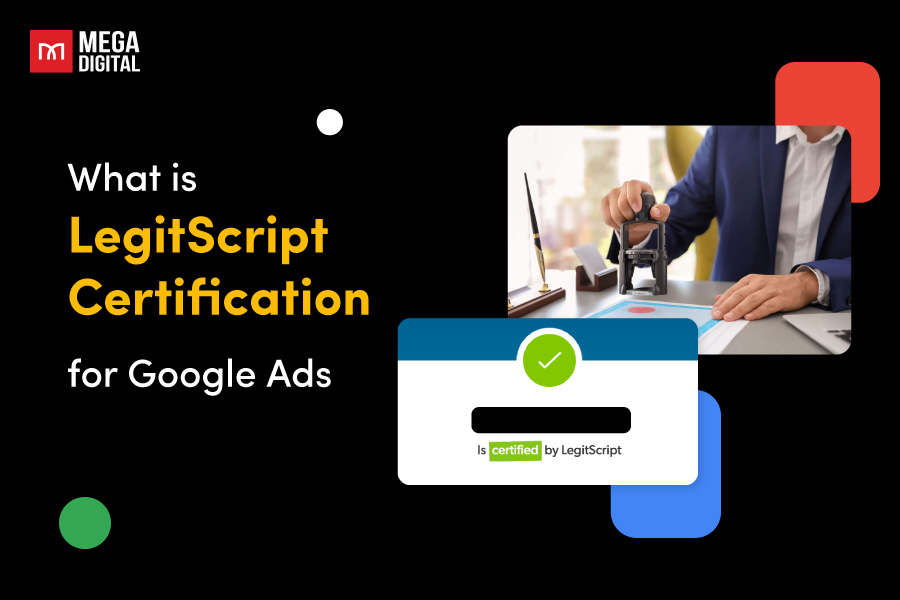Ad arbitrage is a powerful digital marketing strategy where you acquire low-cost web traffic and monetize it through higher-paying ads. This 2026 guide explores the intricacies of ad arbitrage, offering detailed insights on how it works, effective traffic sources, and advanced strategies for scaling your operations. Whether you’re new to ad arbitrage or looking to refine your approach, this comprehensive guide provides the tools and techniques you need to succeed.
QUICK SUMMARY
- Ad arbitrage = buy low-cost traffic, monetize with high-paying ads — simple in theory, tricky in practice.
- Success depends on traffic quality, the right niche selection, and a well-optimized website.
- Ad placement, compelling CTAs, and close tracking of key metrics (CPC, EPMV, CTR, ROAS) are what drive profitability.
- In this guide, you’ll uncover the best traffic sources, the most profitable niches, and how to avoid common pitfalls in ad arbitrage.
- What is Ad Arbitrage?
- How Does Ad Arbitrage Work?
- Common Traffic Sources For Ad Arbitrage
- What to Prepare for a Successful Ad Arbitrage Campaign
- Ad Arbitrage Key Monetization Techniques
- What are the Key Metrics to Track in Ad Arbitrage?
- Advanced Strategies for Scaling
- Common Risks of Ad Arbitrage & How to Mitigate Them
- Future of Ad Arbitrage and Expert Advice from Mega Digital
What is Ad Arbitrage?
Ad arbitrage is a digital marketing strategy where you acquire web traffic at a low cost and monetize it by displaying higher-paying ads. The core idea is to profit from the difference between the cost of acquiring traffic and the revenue generated from ad placements.
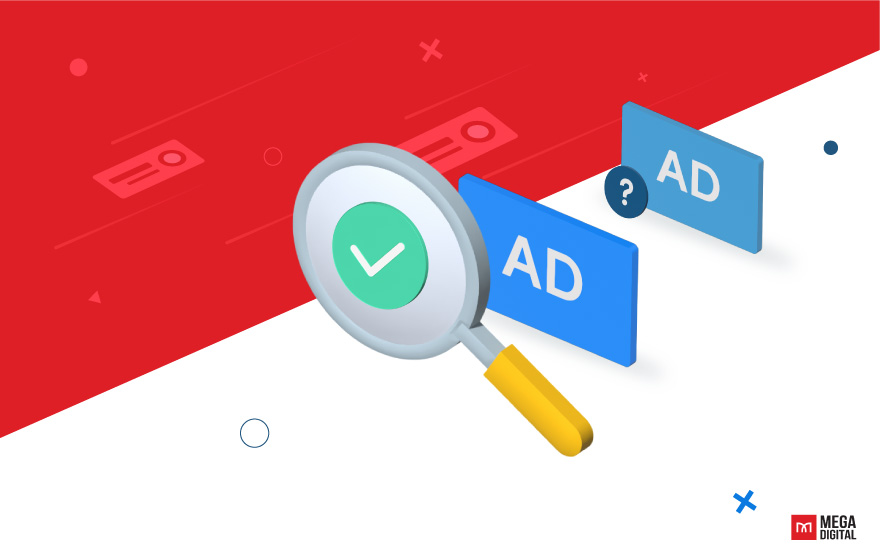
How Does Ad Arbitrage Work?
Typically, the publisher or owner of the site is paid a specific rate per click, so the more ad impressions your site makes, the more profitable it will be. More traffic on the website means more ad impressions, allowing you to make more money.
You must pay less when buying traffic than what you will make through the ad impressions. This model is the only way that traffic arbitrage can work for you. That does not mean the cheapest traffic available is the one for you. In fact, the quality of traffic is just as important as the price. Expensive traffic can result in better ad impressions and a more profitable arbitrage, while cheap traffic can result in little to no profit.
Example:
When you have a website, you can generate revenue by placing ads on it. Let’s assume that typically, every 1000 visitors may give you $1 in ad revenue.
One common form of ad arbitrage is when an online content creator can pay for traffic cheaper than it can charge for ad impressions on its site. In this instance, if you pay a search engine, say 0.50 per 1000 visitors to drive traffic to your site, you end up profiting from the difference, exemplifying ad arbitrage.
Common Traffic Sources For Ad Arbitrage
Successful ad arbitrage relies heavily on acquiring quality traffic at the lowest cost possible. Here are some of the most effective and most commonly used traffic sources:
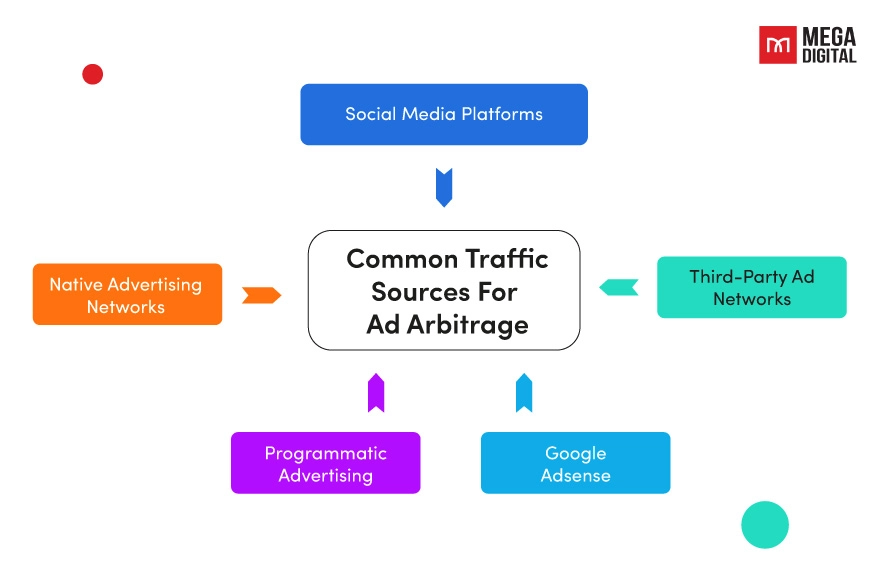
Google Adsense
Google Adsense is one of the most popular platforms for acquiring traffic. It offers extensive targeting options and access to a vast audience.
- Advantages: High-quality traffic, detailed targeting, extensive reach.
- Considerations: Can be expensive; requires careful management to maintain low CPC.
>>> Read more: [Guide] Google Adsense Arbitrage: How to Earn More Profit?
Social Media Platforms
Platforms like TikTok, Facebook, Instagram, Twitter, Instagram, and Quora offer advertising options that can drive substantial traffic to your site.
- Advantages: Detailed audience targeting, high engagement potential, diverse ad formats.
- Considerations: Costs can fluctuate; platform algorithms may affect visibility.
>>> Read more: A Complete Guide to Adsense Arbitrage with Facebook Ads
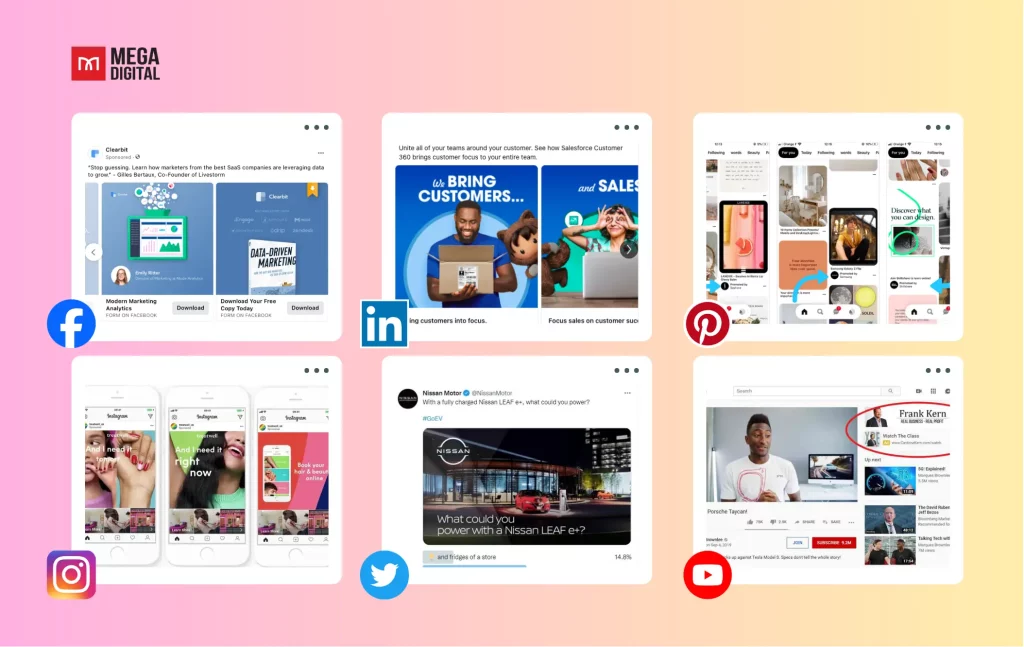
Native Advertising Networks
Networks like Taboola, Outbrain, MGID, and Revcontent place ads that blend seamlessly with the content of the host site.
- Advantages: High engagement rates, better user experience, less intrusive, targeted traffic, scalable.
- Considerations: Requires high-quality and high-relevance content for better performance.
Third-Party Ad Networks
Networks like BuySellAds, Media.net, and AdBlade offer various ad formats and targeting options.
- Advantages: Access to niche audiences, flexible ad formats.
- Considerations: Quality can vary; need to monitor for low-quality traffic sources.
Programmatic Advertising
Platforms like Google AdX and AppNexus use automated technology to buy and sell ad space in real-time.
- Advantages: Efficient, scalable, targeted.
- Considerations: Requires sophisticated tools and knowledge to manage effectively.
What to Prepare for a Successful Ad Arbitrage Campaign
To ensure your ad arbitrage campaign thrives, focus on selecting high-value keyword niches, building a high-quality website, and crafting compelling ad CTAs. These key steps will help you maximize traffic and revenue.
Choose the Best Keywords Niches for Ad Arbitrage
Ad arbitrage thrives on identifying high-value keyword niches where the cost of acquiring traffic is lower than the revenue generated from that traffic. Here are some of the most lucrative keyword niches, including adsense niches, for ad arbitrage:
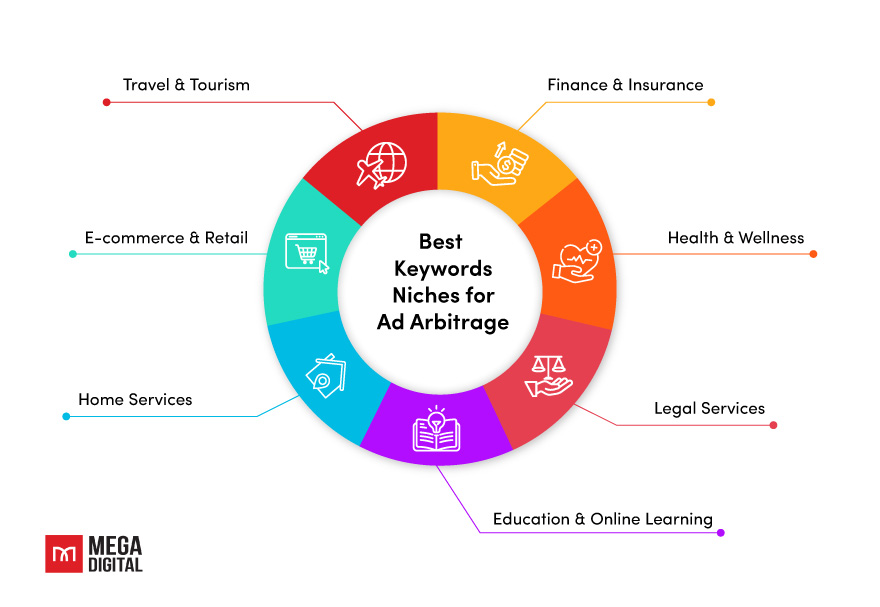
| Industry | Click payoff estimate | Impression payoff estimate (CPM) | Suggested Topics |
|---|---|---|---|
| Finance & Insurance | $2 – $10+ | $15 – $50+ | Car insurance, home insurance, personal loans, credit cards, mortgage refinancing |
| Health & Wellness | $1 – $5+ | $10 – $30+ | Weight loss programs, health supplements, fitness equipment, mental health services, medical treatments |
| Legal Services | $5 – $15+ | $20 – $60+ | Personal injury lawyers, divorce attorneys, estate planning |
| Education & Online Learning | $1 – $6+ | $12 – $40+ | Online degrees, courses, language learning, tutoring services |
| Home Services | $1.5 – $5+ | $15 – $30+ | Plumbing services, HVAC repair, pest control, roofing contractors, landscaping |
| E-commerce & Retail | $1 – $5+ | $8 – $30+ | Electronics, fashion and apparel, beauty products, home decor, sporting goods |
| Travel & Tourism | $1 – $4+ | $8 – $25+ | Flights, hotels, car rentals, vacation packages |
Build a High-Quality Website
Creating a high-quality website is crucial for a successful ad arbitrage campaign. Here are some tips on design, user experience, and essential features:
Design and User Experience
For an effective ad arbitrage website, prioritize responsive design to ensure it functions well on mobile devices and various screen sizes. Optimize your website’s load times to enhance performance, as faster sites keep users engaged. Clear navigation is also critical, allowing visitors to easily locate the information or content they seek, thereby improving overall user experience.
Essential Features
Incorporate high-quality content that is valuable and engaging to attract and retain visitors on your site. Additionally, include interactive elements such as comment sections, polls, and social sharing buttons to boost engagement. These features not only enhance user interaction but also encourage visitors to spend more time on your site, increasing the potential for ad clicks and revenue.
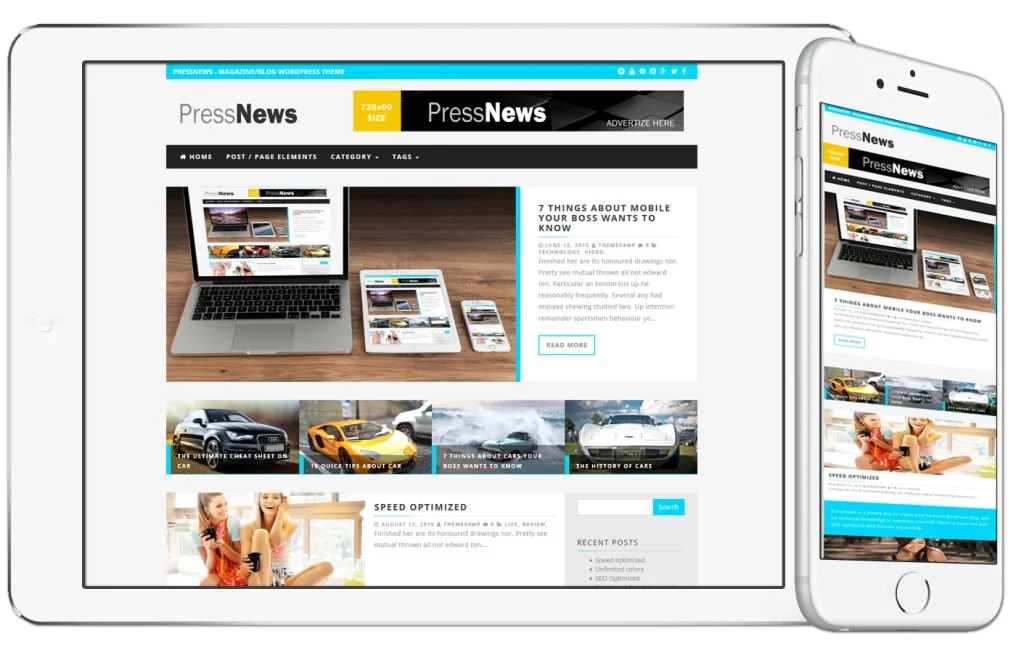
Have Strong Ad CTA Strategies
A strong headline or CTA is essential for guiding users to click on your ads so you can generate ad arbitrage revenue. To encourage clicks, consider these tips:
- Be Clear and Direct: Use clear and direct language for your heading/CTA. Phrases like “Learn More,” “Exclusive,” are effective in creating a sense of uniqueness and tempt interactions from visitors.
- Position Strategically: Place your heading/CTA in a prominent position where it’s easily visible and stands out from the rest of the ad content.
- Targeting FOMO (Fear of Missing Out): For example, “Everybody’s Following This Trend Now,” “Check this video out before it gets removed Today,” etc. are curiosity-driving phrases.
- Evoking Emotions: As people tend to act on their feelings, give them a story that they cannot overlook, like a heartwarming animal rescue story.

Ad Arbitrage Key Monetization Techniques
Ad arbitrage monetization involves various techniques to maximize the revenue from the traffic acquired. Below are key strategies to enhance your ad arbitrage efforts:
Optimizing Ad Placements
Optimizing where and how ads are placed on your site can significantly impact your revenue. Here are some best practices to consider for a few popular ad placements:
Above-the-Fold Ads
Ads placed above the fold (the part of the webpage that is visible without scrolling) tend to have higher visibility and engagement rates.
Best Practices:
- Place banner ads at the top of the page.
- Use sticky ads that remain visible as users scroll.
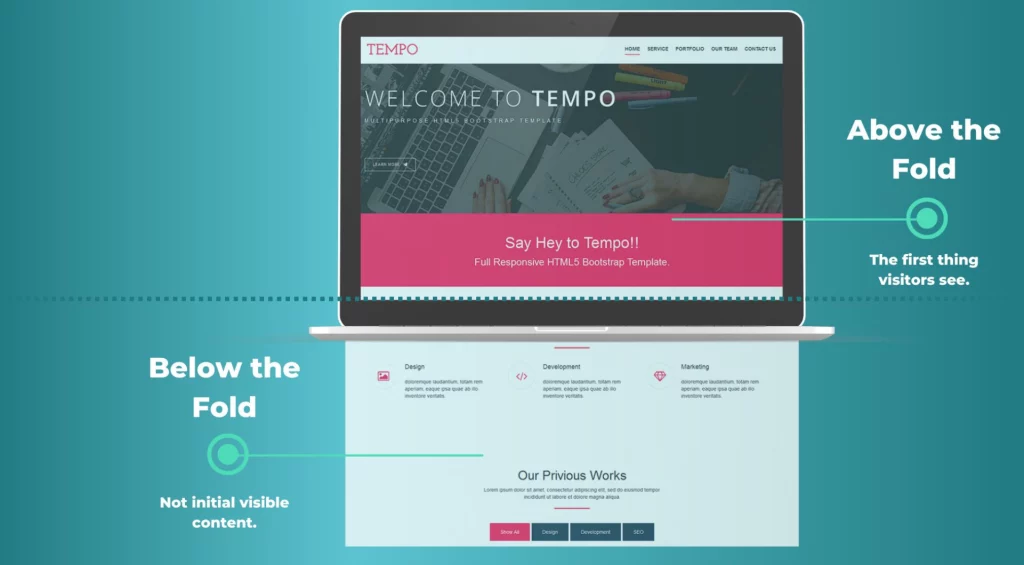
In-Content Ads
With in-content ads, you embed ads within your content to enhance their visibility and relevance, increasing the likelihood of clicks.
Best Practices:
- Integrate native ads seamlessly within articles.
- Use in-feed ads that appear in the middle of content lists.
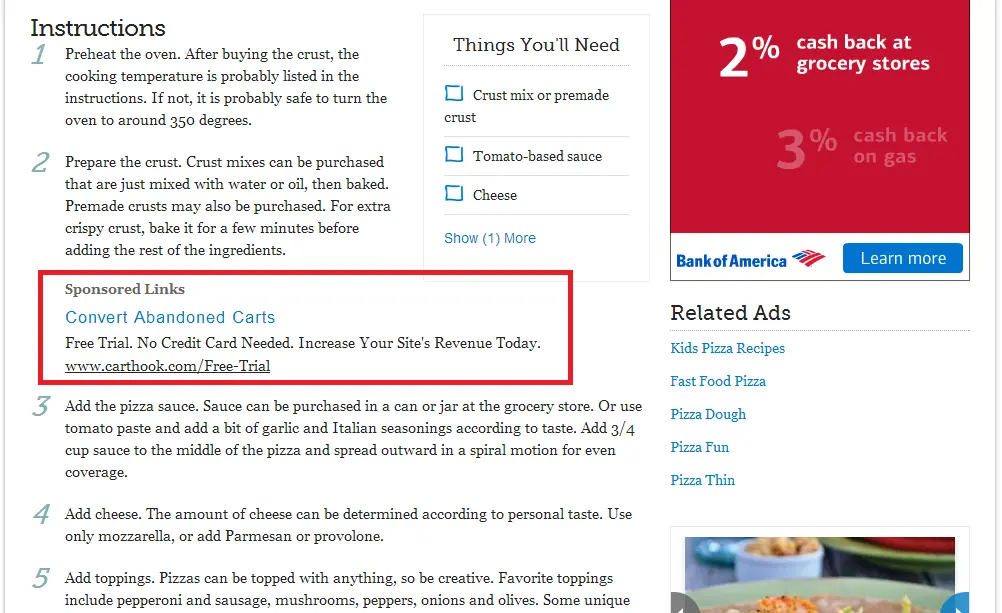
Sidebar Ads
Sidebars are great for displaying ads without interrupting the reading flow of your content.
Best Practices:
- Use sticky sidebars that keep ads visible while scrolling.
- Ensure ads are relevant to the sidebar content to improve engagement.
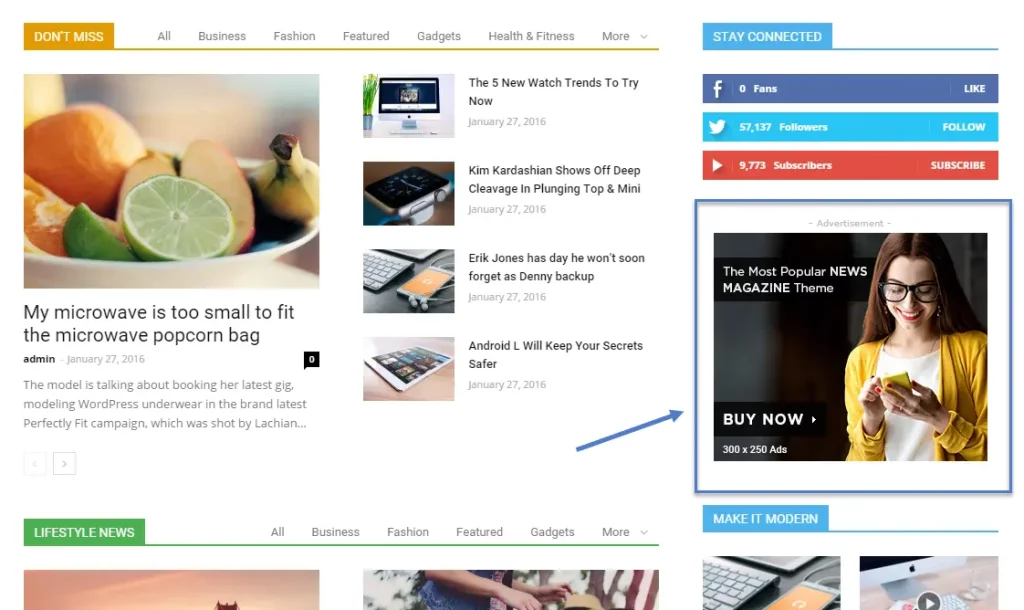
Interstitial and Pop-Up Ads
These ads can capture attention effectively but should be used sparingly to avoid disrupting user experience.
Best Practices:
- Limit the frequency of pop-ups to avoid annoyance.
- Use exit-intent pop-ups to engage users about to leave the site.

Balancing User Experience
While maximizing ad revenue is important, maintaining a positive user experience is crucial for long-term success. Consider applying these strategies to balance ad monetization with user satisfaction:
Avoid Intrusive Ads
Intrusive ads can frustrate users and increase bounce rates.
Best Practices:
- Limit the number of ads per page.
- Avoid full-page ads that obscure content.
Optimize for Speed
Ensure that ads do not significantly slow down your website, as slow load times can negatively impact user experience.
Best Practices:
- Use asynchronous ad loading to improve page speed.
- Optimize images and scripts to reduce load times.

Relevance and Context
Ads should be relevant to the content and interests of your audience to enhance engagement.
Best Practices:
- Use contextual ad networks to match ads with your content.
- Personalize ads based on user behavior and preferences.
Ad Fatigue Management
Frequent exposure to the same ads can lead to ad fatigue, where users start ignoring them.
Best Practices:
- Rotate ads regularly to keep content fresh.
- Use frequency capping to limit the number of times the same ad is shown to a user.
What are the Key Metrics to Track in Ad Arbitrage?
Tracking the right metrics is essential for optimizing your ad arbitrage campaign. By closely monitoring these key performance indicators, you can make data-driven decisions to maximize profitability and efficiency.
Cost Per Click (CPC)
In ad arbitrage, keeping CPC low is crucial because it directly impacts your acquisition cost and overall profitability. For example, if you purchase traffic at $0.10 per click and direct it to a monetized page that earns $0.20 per click, you achieve a profit margin of $0.10 per click. However, if the CPC rises to $0.15, your profit margin drops to $0.05 per click, which can significantly reduce your overall profit.
Earning Per Thousand Visitors (EPMV)
EPMV is a key indicator of how much you’re earning from your traffic. It measures the revenue generated per 1,000 visitors to a website. While it is similar to RPM (Revenue Per Thousand Impressions), it focuses on the number of visitors (sessions) rather than mere impressions, making it a more reliable metric than RPM. You always need to strive for positive EPMV, meaning the cost of traffic acquired must be lower than the revenue generated from that traffic, a fundamental principle of ad arbitrage.
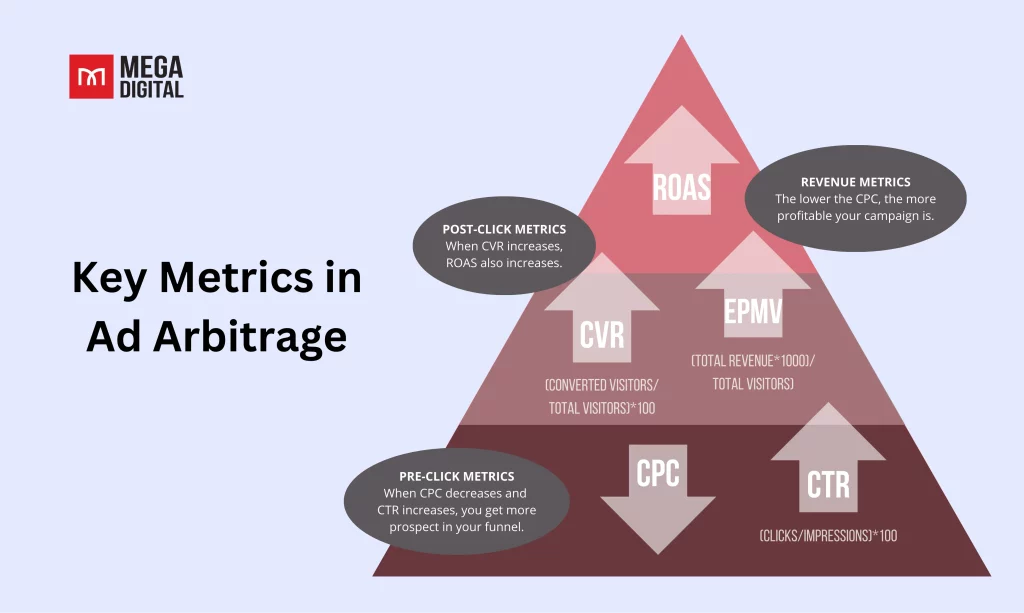
Click-Through Rate (CTR)
CTR is highly relevant in ad arbitrage because it measures how effectively your ads engage the audience and drive clicks. A higher CTR indicates that your ads are compelling, leading to more clicks and potentially higher revenue. For example, improving your CTR from 1% to 2% can potentially double your revenue if the traffic quality remains consistent.
Conversion Rate (CVR)
In ad arbitrage, the conversion rate reflects the quality of your traffic and its potential to generate revenue. A higher CVR means more visitors are taking desired actions, most of the time clicks, significantly boosting your overall revenue. For instance, increasing your conversion rate from 2% to 4% means the number of conversions from the same traffic doubles, leading to an increase in revenue.
Return on Ad Spend (ROAS)
ROAS is a critical metric for assessing the overall efficiency and profitability of your ad spend. It shows how much revenue you are generating for every dollar spent on acquiring traffic. A higher ROAS indicates a successful ad arbitrage strategy. If you spend $1,000 on ads and generate $3,000 in revenue, your ROAS is 3:1. Optimizing your campaigns to increase ROAS to 5:1 would mean generating $5,000 in revenue for the same $1,000 ad spend.
Advanced Strategies for Scaling
As your ad arbitrage operations grow, it’s essential to implement advanced strategies to scale effectively. Here’s an in-depth look at how to expand your ad arbitrage niches, automate processes, and tap into international traffic.
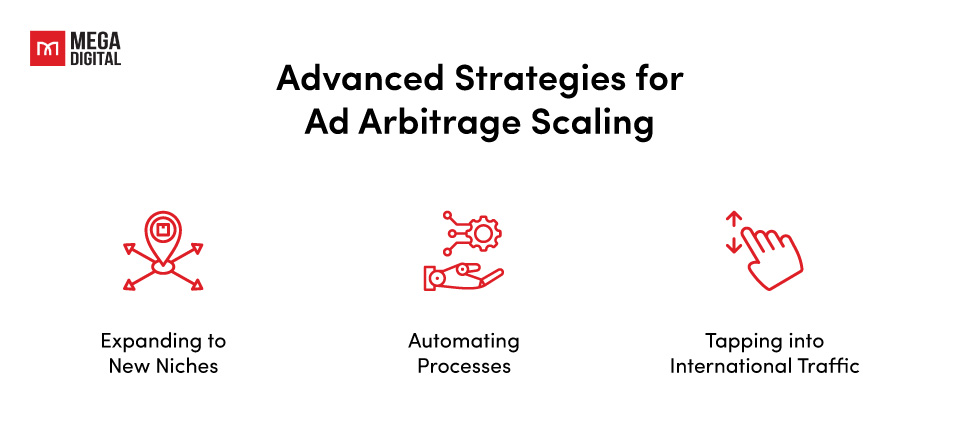
Expanding to New Niches
Expanding into new niches in ad arbitrage diversifies income streams and spreads risk, reducing dependency on a single revenue source. This provides stability even if one niche underperforms. Tools like Ahrefs and SEMrush can help you find high-demand, low-competition niches, and analyze competitors to uncover new opportunities.
Automating Processes
Automation in ad arbitrage saves time and minimizes manual work, allowing you to focus on optimizing strategies. Automate ad management with platforms like Google Ad Manager, content creation with AI tools like Jasper and Copy.ai, and analytics with Google Analytics. Additionally, use chatbots like Intercom and Mailchimp for customer engagement to ensure consistency and 24/7 operation.
Tapping into International Traffic
Reaching international traffic broadens your audience and boosts revenue with possibly higher CPM rates compared to domestic traffic. Use translation tools like Weglot to customize content, adapt it for cultural relevance, and implement international SEO tactics like hreflang tags. Partner with global ad networks like Google AdSense and offer multiple currencies and local payment methods like Alipay (China) or Paytm (India) to increase conversions.
Work with ad networks that have a strong international presence, such as Google AdSense, Media.net, and Taboola. These networks can provide access to high-quality traffic from around the world. Explore region-specific ad networks and platforms to reach niche audiences. For example, Yandex Direct for Russia or Baidu for China.
Common Risks of Ad Arbitrage & How to Mitigate Them
While ad arbitrage can be very profitable, it often comes with certain risks. The most common ones you may encounter are:
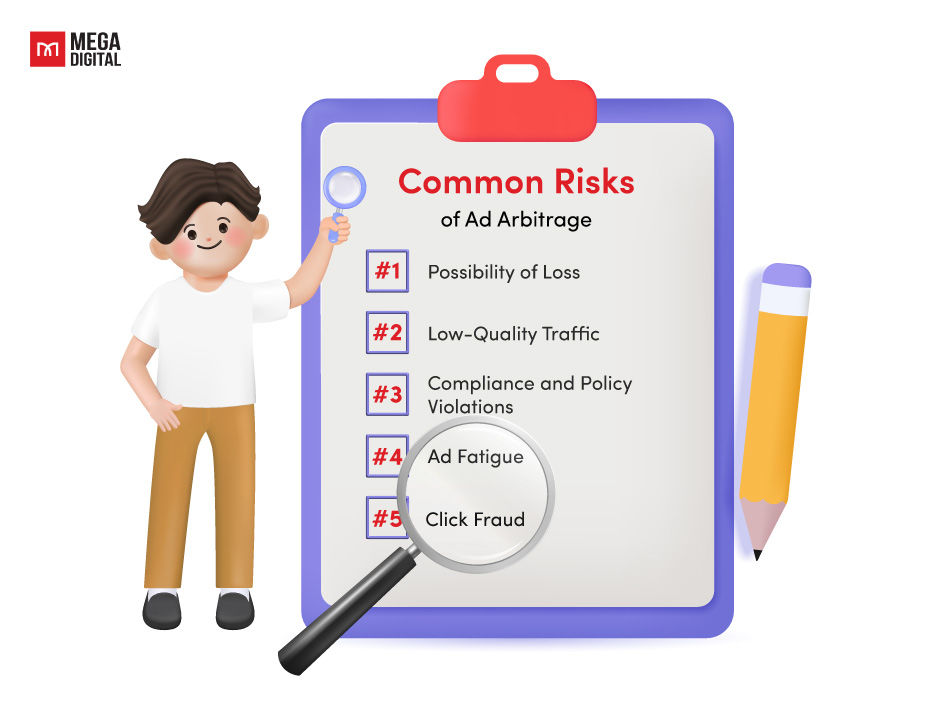
#1 Possibility of Loss
This risk directly impacts the profitability of your ad arbitrage efforts. If you spend more on acquiring traffic than you earn from it, your business model becomes unsustainable.
Mitigation:
- Monitor KPIs: Regularly track key performance indicators (KPIs) such as Cost Per Click (CPC), Revenue Per Click (RPC), and overall ROI.
- Analytics Tools: Utilize analytics tools like Google Analytics and ad network dashboards to monitor spending and earnings in real-time.
- Budget Control: Set strict budgets and adjust bids based on performance data.
#2 Low-Quality Traffic
Low-quality traffic can lead to poor engagement and lower revenue.
Mitigation:
- Advanced Targeting: Use detailed targeting options available on ad platforms to ensure you reach the most relevant audience.
- Regular Audits: Conduct regular traffic quality audits to identify and eliminate low-quality traffic sources.
- Engagement Metrics: Focus on engagement metrics such as bounce rate, time on site, and page views to assess traffic quality.
#3 Compliance and Policy Violations
Compliance with ad network policies is crucial to avoid account suspensions or bans, which can disrupt your business operations and revenue streams.
Mitigation:
- Stay Updated: Regularly review ad network policies and guidelines.
- Quality Content: Ensure your ads and landing pages adhere to quality standards and guidelines.
- Legal Consultation: Consult with legal experts if needed to ensure compliance with all relevant regulations and policies.
#4 Ad Fatigue
Ad fatigue occurs when an audience becomes overly exposed to the same advertisement. When users repeatedly see the same ad, they tend to ignore it, resulting in lower click-through rates (CTR) and decreased revenue.
Mitigation:
- Ad Rotation: Develop multiple versions of your ads with different headlines, images, and calls to action. This variety can keep your audience interested and reduce the chance of fatigue. You can Utilize tools like Google Ad Manager or other ad platforms that offer automated ad rotation features.
- Frequency Capping: Determine an optimal frequency cap (e.g., 3 times per week per user) based on your ad performance data. This helps in maintaining a balance between ad exposure and user engagement.

#5 Click Fraud
Click fraud can result in significant financial losses as fraudulent clicks do not convert into sales or leads. Google Ads click fraud is one of the most common issues that ad arbitrageurs face.
Mitigation:
- Anti-Fraud Measures: Implement robust anti-fraud measures and use ad networks with strong anti-fraud policies.
- Monitoring Tools: Use monitoring tools to detect and block fraudulent activity.
- Trusted Networks: Partner with reputable ad networks known for their effective fraud prevention mechanisms.
#6 Algorithm Changes
Changes in search engine or ad network algorithms can significantly impact your traffic acquisition and ad performance.
Mitigation:
- Stay Informed: Keep up-to-date with industry news and updates from ad networks.
- Flexible Strategies: Be ready to adapt your strategies quickly in response to algorithm changes.
- Diversify Traffic Sources: Reduce dependence on a single platform by diversifying your traffic sources.
Future of Ad Arbitrage and Expert Advice from Mega Digital
The future of ad arbitrage is poised for significant evolution, driven by technological advancements and changing market dynamics. Artificial intelligence (AI) and machine learning will play a crucial role, enabling more precise predictive analytics and automated ad placements to optimize performance and maximize returns.
Video ads will become increasingly prominent due to their higher engagement rates, offering new opportunities for content creators to monetize their traffic effectively. Programmatic advertising will continue to grow, providing real-time bidding and highly targeted ad placements, making ad campaigns more efficient and effective.
Additionally, arbitrageurs should always stay compliant with evolving privacy regulations and ad policies to avoid penalties and maintain trust with users. As new technologies and platforms emerge, adapting to these changes and utilizing innovative strategies will be key to staying competitive and achieving sustained success in the ad arbitrage landscape.
>>> Read more: What is Search Arbitrage? A Beginner’s Guide And Key Insights
Final Word
While ad arbitrage comes with certain challenges, the potential for substantial revenue makes it a worthwhile money making method. Hopefully, with the strategies and tips in this guide, you can now confidently start your own ad arbitrage journey! Don’t forget to check out Mega Digital’s blog for more insights and updates on the latest trends in digital marketing and ad arbitrage.







